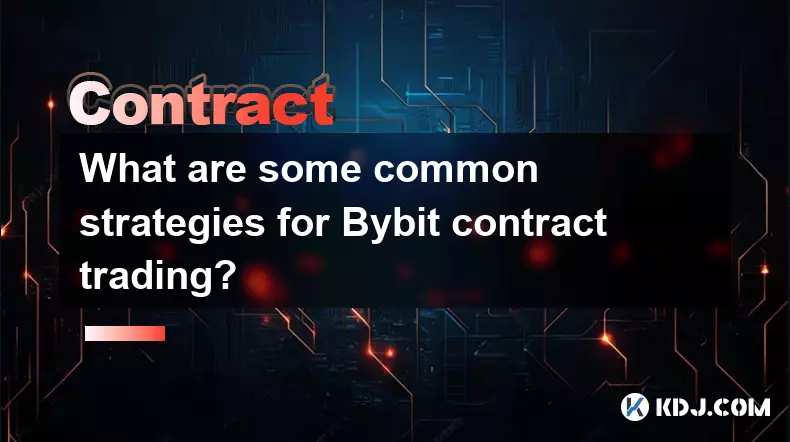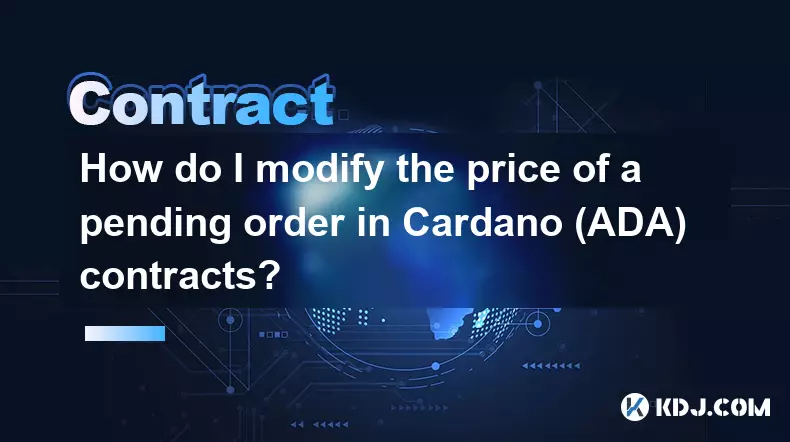-
 bitcoin
bitcoin $109667.069529 USD
-3.03% -
 ethereum
ethereum $3936.685804 USD
-4.07% -
 tether
tether $1.000493 USD
0.01% -
 xrp
xrp $2.771823 USD
-4.74% -
 bnb
bnb $957.805027 USD
-5.34% -
 solana
solana $196.735100 USD
-6.68% -
 usd-coin
usd-coin $0.999727 USD
-0.01% -
 dogecoin
dogecoin $0.227355 USD
-5.12% -
 tron
tron $0.335205 USD
-0.81% -
 cardano
cardano $0.779256 USD
-3.59% -
 ethena-usde
ethena-usde $0.999900 USD
-0.06% -
 hyperliquid
hyperliquid $42.492095 USD
-6.61% -
 chainlink
chainlink $20.501853 USD
-4.34% -
 avalanche
avalanche $28.952606 USD
-11.21% -
 stellar
stellar $0.356038 USD
-3.93%
What are some common strategies for Bybit contract trading?
Using isolated margin on Bybit limits risk per trade by allocating specific collateral, preventing total account liquidation.
Sep 17, 2025 at 11:00 pm

Understanding Leverage in Bybit Contract Trading
1. Traders on Bybit can select leverage ranging from 1x to 100x depending on the contract type and market conditions. Higher leverage amplifies both potential gains and losses, making risk assessment critical before entering a position.
2. Adjusting leverage dynamically based on market volatility helps preserve capital during uncertain periods. Reducing leverage during high-impact news events minimizes exposure to sudden price swings.
3. Using isolated margin mode allows traders to control risk per trade by allocating specific amounts of collateral to each position, preventing total account liquidation.
4. Monitoring maintenance margin levels closely ensures early detection of potential liquidations. Setting conservative leverage reduces the likelihood of being stopped out prematurely.
5. Some experienced users employ tiered leverage strategies—starting with lower leverage and increasing it as the trade moves favorably—to balance aggression with safety.
Employing Technical Analysis for Entry and Exit Points
1. Candlestick patterns such as engulfing bars, doji formations, and wicks are frequently used to identify reversals or continuations in price action on Bybit’s trading interface.
2. Moving averages, particularly the 50-period and 200-period EMAs, help determine trend direction. A crossover may signal a shift in momentum suitable for initiating long or short positions.
3. The Relative Strength Index (RSI) is widely applied to detect overbought or oversold conditions, especially when divergence appears between price and oscillator readings.
4. Fibonacci retracement levels assist in identifying potential support and resistance zones where price might react, offering strategic locations for placing limit orders or stop-losses.
5. Volume profile analysis reveals areas of high transaction activity, which often act as strong support or resistance. Sudden spikes in volume can confirm breakout validity.
Managing Risk Through Position Sizing and Stop-Loss Placement
1. Fixed fractional position sizing—allocating a consistent percentage of capital per trade—helps maintain discipline and prevents overexposure after consecutive wins or losses.
2. Placing stop-loss orders beyond key technical levels, such as recent swing highs or lows, avoids premature exits caused by market noise.
3. Traders often use trailing stops to lock in profits while allowing room for price fluctuations, especially during strong trending moves on perpetual contracts.
4. Avoiding emotional adjustments to stop-loss levels mid-trade preserves strategy integrity. Predefining exit rules before entry improves consistency.
5. Calculating position size using the distance between entry and stop-loss ensures that maximum acceptable loss per trade remains within predefined risk limits, typically under 2% of total equity.
Frequently Asked Questions
What is the difference between cross margin and isolated margin on Bybit?Cross margin uses the entire wallet balance as collateral for a position, increasing risk but providing more buffer against liquidation. Isolated margin assigns a fixed amount of margin to a trade, limiting both risk and potential liquidation impact to that specific position.
How does funding rate affect Bybit futures trading?Funding rates are periodic payments exchanged between long and short traders to anchor futures prices to spot values. Holding positions through funding intervals results in either receiving or paying fees based on the rate's sign, influencing cost efficiency for longer-term trades.
Can I automate my Bybit contract trading strategies?Yes, Bybit supports API integration, enabling traders to connect third-party bots or custom scripts for automated execution based on technical signals, price alerts, or algorithmic models.
What happens when a contract position gets liquidated?Upon liquidation, Bybit closes the position to prevent further losses. The insurance fund covers residual deficits, and traders lose the margin allocated to that trade. Partial liquidations may occur under certain risk management mechanisms.
Disclaimer:info@kdj.com
The information provided is not trading advice. kdj.com does not assume any responsibility for any investments made based on the information provided in this article. Cryptocurrencies are highly volatile and it is highly recommended that you invest with caution after thorough research!
If you believe that the content used on this website infringes your copyright, please contact us immediately (info@kdj.com) and we will delete it promptly.
- Riding the Crypto Wave: Ether Supercycle, Circle's Reversibility Debate, and Aster's DEX Surge
- 2025-09-27 02:45:12
- Shiba Inu's ETF Dreams: Navigating US Market Conditions
- 2025-09-27 03:05:12
- Dogecoin's Wild Ride: From Mining Moves to Meme Coin Mania – Can DOGE See 70x Growth?
- 2025-09-27 03:05:12
- Solana, Ruvi AI, and Institutional Backing: Navigating the Crypto Landscape
- 2025-09-27 02:25:16
- Momentum, Yield Campaigns, and Liquidity Expansion: Decoding the Latest Trends
- 2025-09-27 03:45:13
- Quant, CBDCs, and Crypto: Decoding the Future of Finance, Ya Heard?
- 2025-09-27 02:45:12
Related knowledge

How do I enable the "scalping-only" mode for Cardano (ADA) contracts?
Sep 24,2025 at 03:19am
Understanding Scalping Strategies in Crypto Derivatives1. Scalping in cryptocurrency trading refers to executing multiple short-term trades within min...

What is the maximum position limit for Cardano (ADA) contracts?
Sep 23,2025 at 11:00pm
Understanding ADA Futures and Derivatives Market Structure1. Cardano (ADA) futures contracts are offered by several major cryptocurrency derivatives e...

What is the maker fee for Cardano (ADA) contracts?
Sep 26,2025 at 09:01am
Understanding Maker Fees in Cardano (ADA) Contracts1. The concept of maker fees applies broadly across decentralized exchanges and smart contract plat...

How can I view open interest in Cardano (ADA) contracts?
Sep 24,2025 at 07:36am
Understanding Open Interest in Cardano Derivatives1. Open interest refers to the total number of outstanding derivative contracts, such as futures or ...

How do I modify the price of a pending order in Cardano (ADA) contracts?
Sep 27,2025 at 01:00am
Understanding Pending Orders in Cardano Smart Contracts1. Cardano operates on a proof-of-stake blockchain that supports smart contracts through its Pl...

What is the function of the insurance fund in Cardano (ADA) contracts?
Sep 24,2025 at 02:18am
Understanding the Role of Insurance Funds in Cardano Smart Contracts1. The insurance fund within Cardano's ecosystem is not a native feature directly ...

How do I enable the "scalping-only" mode for Cardano (ADA) contracts?
Sep 24,2025 at 03:19am
Understanding Scalping Strategies in Crypto Derivatives1. Scalping in cryptocurrency trading refers to executing multiple short-term trades within min...

What is the maximum position limit for Cardano (ADA) contracts?
Sep 23,2025 at 11:00pm
Understanding ADA Futures and Derivatives Market Structure1. Cardano (ADA) futures contracts are offered by several major cryptocurrency derivatives e...

What is the maker fee for Cardano (ADA) contracts?
Sep 26,2025 at 09:01am
Understanding Maker Fees in Cardano (ADA) Contracts1. The concept of maker fees applies broadly across decentralized exchanges and smart contract plat...

How can I view open interest in Cardano (ADA) contracts?
Sep 24,2025 at 07:36am
Understanding Open Interest in Cardano Derivatives1. Open interest refers to the total number of outstanding derivative contracts, such as futures or ...

How do I modify the price of a pending order in Cardano (ADA) contracts?
Sep 27,2025 at 01:00am
Understanding Pending Orders in Cardano Smart Contracts1. Cardano operates on a proof-of-stake blockchain that supports smart contracts through its Pl...

What is the function of the insurance fund in Cardano (ADA) contracts?
Sep 24,2025 at 02:18am
Understanding the Role of Insurance Funds in Cardano Smart Contracts1. The insurance fund within Cardano's ecosystem is not a native feature directly ...
See all articles










































































